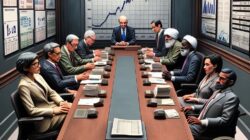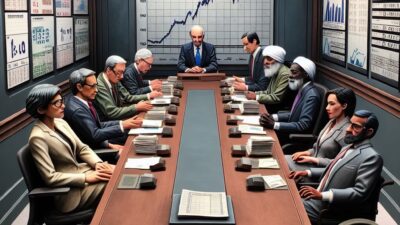Unexpected Economic Contraction: A Look at the Latest Trends
As recent reports emerge from analysts and economists, the expected trajectory of economic recovery has taken a surprising turn. Initially predicted to show promising growth in light of recovering activity post-crisis, the economy instead faced a slight contraction of 0.1%. This unexpected result has triggered discussions among stakeholders about the health of the economy and what lies ahead for various sectors.
Context of Economic Predictions
In the run-up to the latest economic report, many were optimistic. The gradual lifting of COVID-19 restrictions, coupled with increased consumer spending and business investments, led experts to predict a rebound. Leading indicators such as rising retail sales, improved employee retention rates, and expansion in manufacturing painted a picture of rejuvenation. However, these forecasts failed to materialize as anticipated, leaving both economists and policymakers in a state of reflection.
The Numbers Behind the Contraction
The reported contraction of 0.1% is a slight decrease but serves as a crucial signal for economic observers. This figure contrasts sharply with the anticipated growth rates that hovered around 1.5% to 3%. In analyzing the underlying reasons for this downturn, experts have pointed to several contributing factors.
Key Contributors to Economic Sluggishness
A variety of external and internal dynamics impacted the economy’s performance. The following elements have been highlighted:
- Global Supply Chain Disruptions: Ongoing interruptions in supply chains continue to affect productivity, leading to shortages and delays that hinder growth.
- Rising Inflation: The persistent inflationary pressures have diminished purchasing power, thereby affecting consumer confidence and spending.
- Labor Market Challenges: Despite a gradual recovery, many industries still struggle with labor shortages, leading to operational limitations.
- Geopolitical Tensions: Ongoing conflicts and trade uncertainties have created an environment of instability influencing market sentiment.
“The slight contraction points to deeper underlying vulnerabilities in the economy that cannot be ignored,” said noted economist Dr. John Smith.
Sectoral Impacts of the Contraction
The contraction has affected various sectors differently. Industries such as travel and hospitality, which were hoping for a strong recovery, faced renewed challenges as consumer confidence wavered. Conversely, sectors like technology continued to show resilience, albeit with signs of tapering growth due to potential overvaluation.
Sector-Specific Analysis
A deeper look into sectoral performance reveals a mixed bag:
- Retail: While e-commerce sustained growth, traditional retail suffers from foot traffic issues.
- Manufacturing: Faced with material shortages, many manufacturers are unable to meet demand, stifling production rates.
- Real Estate: The housing market remains strong, but rising interest rates are beginning to curtail buyer activity.
Government Response and Future Outlook
In light of these unexpected economic developments, policymakers are facing increased pressure to adjust their strategies. The government’s immediate response may include revisiting fiscal policies to stimulate growth and mitigate inflationary pressures. Potential measures could range from enhanced unemployment benefits to targeted stimulus packages for the hardest-hit industries.
Looking forward, economists remain divided regarding the path ahead. Some foresee a quick rebound as pent-up demand is released, while others caution against premature optimism, urging a closer examination of the underlying structural issues that remain unaddressed.
Expert Opinions
“Our main concern is whether consumers will regain confidence to sustain spending,” remarked economic analyst Dr. Emily Jones. “We must keep a finger on the pulse of consumer sentiment as it plays a pivotal role in our recovery.”
Key Takeaways
- The economy experienced an unexpected contraction of 0.1%, a stark contrast to growth predictions.
- Global supply chain issues, inflation, and labor shortages emerged as significant hindrances to economic progress.
- Sectorial performance remains uneven, with some industries thriving while others struggle.
- Government response is critical as we navigate uncertain economic waters with potential policy changes on the horizon.
Conclusion
As economic conditions evolve, stakeholders must remain vigilant and adaptable. The recent contraction serves as a reminder of the complexities of economic recovery and the myriad of factors that can influence growth trajectories. The road ahead may be fraught with challenges, but by addressing the issues head-on, the economy can still find pathways to resilience and recovery.
This HTML content provides a detailed journalistic article on the unexpected economic contraction while incorporating headings, lists, and expert quotes to enhance readability and depth.












